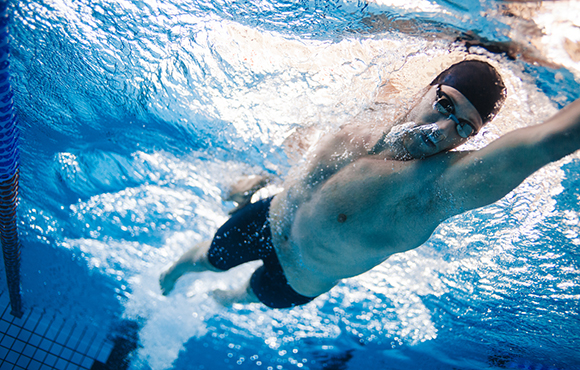Improving your Freestyle Swim Stroke with Rotation and Body Roll
By Phil Gerrard, Updated 22nd of May 2021

So what is rotation and body roll in freestyle? They are two terms for the same concept. Start by imagining your body floating at the surface of the water, lying flat - in a stretched out position for minimal drag. Now draw a line through your body from the end of your pointed toes to the tip of your outstretched fingers. This is the axis around which an efficient freestyle swimmer will rotate. There are many reasons to rotate in freestyle - the main being you can achieve a longer stroke and you can also apply more power with larger muscle groups. It also makes the recovery arm phase of your stroke easier.
How to make it happen?
I have seen so many swimmers that understand rotation is an important aspect of the freestyle stroke, but can’t figure out how to make it happen in a productive way! My tip is don’t aim for rotation, aim for increased stroke length and power. Of length and power, stroke length is the easiest place to start.
Think for now about reach when considering stroke length. Try this exercise on land. Stand feet together, toes against a wall. Use one arm to reach up the wall as far as you can. Really stretch for the highest point you can. Did you notice anything happen? If you really stretched for that last few millimeters, you most likely felt your shoulder turn in and your body slightly rotate inwards. Replicate this in the pool, and you are well on your way to functional rotation (and a great long reaching stroke.)
Reaping the benefits of rotation
What you should notice when stretching out in the pool in the manner described above, is that while you are outstretched with one arm, the rotation leads to a pleasant positioning for your recovery arm. How many times you have been told to have a high elbow? Well rotation makes it natural…
The other benefit of rotation that I mentioned was the ability to apply more power with larger muscle groups. I’m guessing this is the benefit most swimmers want when they are trying to figure out how rotation works. If you have ever felt your shoulder muscles burning and making you need to stop, you may have an over reliance on shoulder strength for your stroke. So let’s figure out how to take the pressure off your shoulders with rotation. Let’s go back to that position in the water with one arm outstretched as discussed earlier. Think about when you will begin to rotate from this outstretched position. What do you need if rotation is to provide stroke power?
…thinking time… thinking time… thinking time…
Ok, I hope that’s enough time! If you are getting power from rotation, you need somewhere to apply that power. If you were in a canoe, you would apply rotation power into the oar. When you are swimming, you need to apply that rotation power into your paddle - also known as your hand and forearm. This is starting to lead down a discussion of EVF, or Early Vertical Forearm - but I’ll keep that for another article. The key message being that if we expect power from rotation, we need to have our underwater arm in an appropriate position to make use of the power from rotation BEFORE we begin rotation.
But when does the next rotation begin? As your recovery arm starts to move past your shoulder and you drive your recovery arm forward, you need to initiate rotation to achieve the next outstretched arm. Time this well with a nicely prepared paddle, and that rotation gives you some serious pulling power from the large muscles of your torso. Your shoulders will thank you, and with some time and practice, lap times will benefit.
Correctly implementing effective rotation takes time and patience. New technique won’t come straight away. If you are a swimmer that pushes themselves physically each swim, be sure to take it slow with this one. Maybe set aside 20 minutes or so each swim to feel out your stroke technique and timing at a leisurely pace. If you struggle to stop pushing yourself, remember, in swimming technique beats strength!